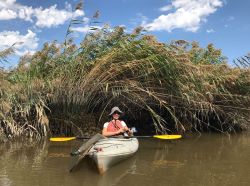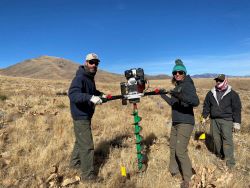Krista Hoffmann at North Table Mountain.

Conducting fieldwork for a Suisun Marsh restoration project.

Conducting fieldwork for a Suisun Marsh restoration project.
Krista Hoffmann is CDFW’s Integrated Pest Management Coordinator. She works in CDFW’s Lands Program coordinating the management of invasive vegetation and invasive species on state wildlife areas and ecological reserves. Krista attended the University of California, Davis (UC Davis), where she earned an undergraduate degree in ecology and evolutionary biology and a doctoral degree in pharmacology and toxicology. Before joining CDFW in 2020, Krista worked for the California Department of Water Resources and prior to that served in the Peace Corps in Palau, Micronesia.
What is your role as Integrated Pest Management Coordinator?
I coordinate weed management which includes ensuring that staff who use herbicides have the correct certifications and training, and that as a department we are following regulations and internal guidelines. I provide information on best management practices and help land managers with problem solving to find the best solution for invasive species on the properties they manage. I read a lot of scientific literature to keep up with new research. I compile data and review weed management plans, among other things. But one of my favorite parts of the job is when I get to do field work. The hands-on restoration work, getting my hands dirty and getting the field experience, is one of the most important parts of my job that helps me understand what’s really happening on the ground.
Integrated pest management is an ecosystem-based strategy to control or eradicate invasive species and includes prevention, treatment and monitoring of invasive species populations. It’s “integrated” in that multiple tools are typically used to enhance efficacy and reduce non-target impacts. The approach also includes active or passive restoration with native, desirable plants to help outcompete or prevent reinvasion by unwanted species.
What motivated you to follow this career path?
I was always interested in science and nature. I was one of those kids who caught and played with most of the critters I could find around my neighborhood, from pill bugs and spiders to lizards and snakes. I was always really fascinated by animals and plants and loved being outside. I also loved learning about science and nature and how things work. I knew I wanted to go into science when I started college. I was also really interested in cultures and the idea of traveling to learn about cultures around the world.
How did you start working on invasive species and toxicology?
I did an undergraduate research project in Dr. Donald Stong’s Spartina Lab at UC Davis. I worked with one of his researchers, Dr. Debra Ayres, who was looking at the hybridization (crossing) between the native Spartina foliosa cordgrass and the non-native Spartina alterniflora from the East Coast and how the resulting hybrid species was more vigorous and more competitive than either of the parent species. Now, the Invasive Spartina Control Project, primarily led by Dr. Drew Kerr, has eradicated over 90 percent of the invasive or hybrid species in the San Francisco Bay Area. It’s a major success story in the world of invasive species management.
Studying toxicology was inspired by a job I had prior to graduate school where I collected water samples from agricultural fields to test for pesticide residues. That’s how I became aware of all the chemicals that are in our waterways and interested in how they might affect aquatic species like fish. Now as a scientist at CDFW I’ve been able to put my two interests together. A lot of what I do now is determining both where herbicides are needed to control invasive species and how to protect non-target species at the same time.
Can you describe the approach to managing invasive plants on CDFW-managed lands?
We use a variety of methods on our lands. For example, grazing by cows, sheep or goats can remove invasive species while promoting native species if it’s done right. We also are looking into using prescribed (planned) fire to remove some species, or flooding for others, and physical methods like mowing and hand pulling are commonly used. There are cool new tools using drones to monitor species or even to control species in a very targeted way. Herbicides are also an important tool that we use, often in combination with other approaches. Decisions on which tools are most appropriate for a given target and setting are based on a combination of information from the scientific literature and hands-on experience, and we adapt our approaches as needed as new tools or evidence become available.
What are some of the most problematic species you work on?
There are lots of them! However, not all non-native species are invasive. “Invasive” plants are those that cause harm to the environment or the economy. A few that cause a lot of problems on our lands are yellow starthistle, perennial pepperweed, cheatgrass and European beachgrass. Some aquatic invasive plants are Phragmites (common reed), Spartina (smooth cordgrass), giant reed, water hyacinth and water primrose. I’m fortunate that I’ve been able to work with regional staff on a few hands-on restoration projects addressing some of these especially problematic plants. At the Hallelujah Junction Wildlife Area in Sierra County, we are studying different control methods for cheatgrass, and how to put a stop to the fire cycle that it perpetuates such as using herbicides and planting native species that compete with cheatgrass. I’m also assisting with a large-scale restoration project in our Northern Region, aiming to control European beachgrass in the dune habitat and Spartina in the tidal wetlands. In Suisun Marsh, there’s been a recent surge in the alkali Russian thistle population, which is impacting waterfowl habitat. I’m working with the Suisun Resource Conservation District to develop a Russian Thistle Control Plan for the region.
Do you have any advice for young scientists?
Do lots of different things. Don’t think you need to stick to one direct career path to be successful. It’s a great idea to get a diversity of experience when you’re starting out. It’s the best way to figure out what you enjoy doing and you never know what skills might come in handy down the road.